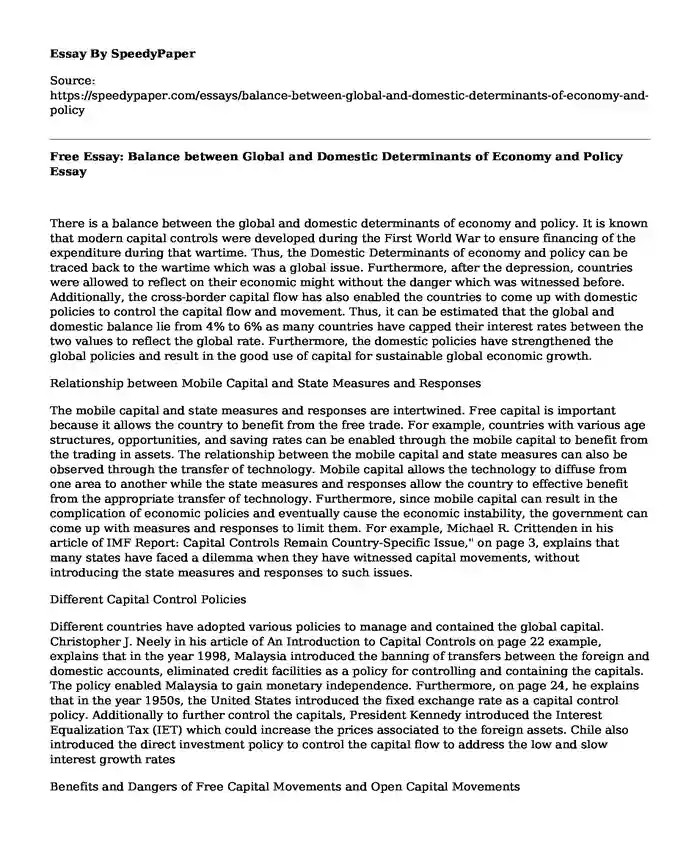There is a balance between the global and domestic determinants of economy and policy. It is known that modern capital controls were developed during the First World War to ensure financing of the expenditure during that wartime. Thus, the Domestic Determinants of economy and policy can be traced back to the wartime which was a global issue. Furthermore, after the depression, countries were allowed to reflect on their economic might without the danger which was witnessed before. Additionally, the cross-border capital flow has also enabled the countries to come up with domestic policies to control the capital flow and movement. Thus, it can be estimated that the global and domestic balance lie from 4% to 6% as many countries have capped their interest rates between the two values to reflect the global rate. Furthermore, the domestic policies have strengthened the global policies and result in the good use of capital for sustainable global economic growth.
Relationship between Mobile Capital and State Measures and Responses
The mobile capital and state measures and responses are intertwined. Free capital is important because it allows the country to benefit from the free trade. For example, countries with various age structures, opportunities, and saving rates can be enabled through the mobile capital to benefit from the trading in assets. The relationship between the mobile capital and state measures can also be observed through the transfer of technology. Mobile capital allows the technology to diffuse from one area to another while the state measures and responses allow the country to effective benefit from the appropriate transfer of technology. Furthermore, since mobile capital can result in the complication of economic policies and eventually cause the economic instability, the government can come up with measures and responses to limit them. For example, Michael R. Crittenden in his article of IMF Report: Capital Controls Remain Country-Specific Issue," on page 3, explains that many states have faced a dilemma when they have witnessed capital movements, without introducing the state measures and responses to such issues.
Different Capital Control Policies
Different countries have adopted various policies to manage and contained the global capital. Christopher J. Neely in his article of An Introduction to Capital Controls on page 22 example, explains that in the year 1998, Malaysia introduced the banning of transfers between the foreign and domestic accounts, eliminated credit facilities as a policy for controlling and containing the capitals. The policy enabled Malaysia to gain monetary independence. Furthermore, on page 24, he explains that in the year 1950s, the United States introduced the fixed exchange rate as a capital control policy. Additionally to further control the capitals, President Kennedy introduced the Interest Equalization Tax (IET) which could increase the prices associated to the foreign assets. Chile also introduced the direct investment policy to control the capital flow to address the low and slow interest growth rates
Benefits and Dangers of Free Capital Movements and Open Capital Movements
The economics professionals have explained that free capital movements and open capital movements are attributed to many benefits. Such movements allow various nations to invest heavily on their economic differences. It has been noted that free and capital movements enable the nations to trade consumptions in the coming days and effectively carry out the intertemporal trade. For example, the Japanese president can be enabled through the free and open capital movement to purchase U.S assets since it has a huge aging population. It allows Japan to build on future income and save for its population for retirement benefits and permit the U.S. residents to borrow the finances from Japan at lower interest rates which allow Japan to accumulate more money for its use during the retirement age of its population.
Through the free and open capital movements, the countries are permitted to avoid many falls with regards to national consumption from natural disaster and other falls by borrowing from other countries of the world and also selling its assets. For example, after the Italian earthquake incident in the year 1980, where 4800 died, the Italians were allowed to borrow from other countries to address the problem. Furthermore, free and open capital is also significant because it allows many states to borrow money for the improvement of goods and services production, for example, finances can be borrowed to improve education.
Even though the free and open capital movement are attributed with many benefits, it is also associated with a myriad of economic dangers. The most important danger associated with free and open capital movement is that it results in a higher inflation rate. It also results in the debt to the country due to unhealthy interest rates. The country might also be subjected to the capital flight which is risky. It can also create a balance of payment deficits.
Cite this page
Free Essay: Balance between Global and Domestic Determinants of Economy and Policy. (2019, Dec 04). Retrieved from https://speedypaper.com/essays/balance-between-global-and-domestic-determinants-of-economy-and-policy
Request Removal
If you are the original author of this essay and no longer wish to have it published on the SpeedyPaper website, please click below to request its removal:
- Free Essay Sample on Fitness Trackers
- Free Essay Sample on Teenage Pregnancies
- Free Essay on Methodologies of Software Development
- Free Essay Example: Exposing the Truth About Guns
- Free Essay on Scientific Methods of Research
- The Consequences of Raising the Minimum Wage Free Essay
- Paper Example: Difference Between Public and Private Law
Popular categories





